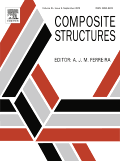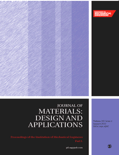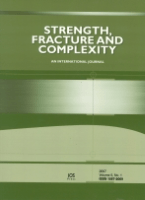
STRENGTH OF MATERIALS
Scope & Guideline
Illuminating the path of material performance analysis.
Introduction
Aims and Scopes
- Material Behavior Under Stress:
The journal emphasizes research on how different materials respond to various stress conditions, including static and dynamic loads, cyclic loading, and thermal conditions. - Innovative Testing and Simulation Techniques:
There is a strong focus on developing and applying advanced testing methods and numerical simulation techniques, such as finite element analysis (FEA) and computational mechanics, to predict material behavior. - Failure Analysis and Damage Mechanisms:
Papers often explore the mechanisms of failure, including fracture toughness, fatigue, and corrosion, providing insights into the durability and reliability of materials. - Structural Integrity and Optimization:
Research addresses the optimization of structural components to enhance their performance and safety, particularly in engineering applications such as aerospace, civil, and mechanical engineering. - Emerging Materials and Technologies:
The journal covers innovative materials, such as composites and advanced alloys, along with modern manufacturing techniques like additive manufacturing and surface treatment processes.
Trending and Emerging
- Advanced Composite Materials:
Research on composite materials, particularly those with enhanced properties for applications in aerospace and automotive engineering, has gained significant attention. - Additive Manufacturing and 3D Printing:
The emergence of additive manufacturing technologies has led to an increase in studies focusing on the mechanical properties and optimization of 3D-printed materials. - Sustainability and Eco-Friendly Materials:
There is a growing trend towards researching sustainable materials and processes, reflecting a global emphasis on reducing environmental impact in engineering. - Multiscale Modeling and Simulation:
The use of multiscale modeling approaches that combine molecular dynamics with continuum mechanics is increasingly prevalent, allowing for more accurate predictions of material behavior. - Interdisciplinary Approaches to Material Science:
Research that integrates principles from physics, chemistry, and engineering to solve complex materials challenges is on the rise, showcasing the interdisciplinary nature of modern materials science.
Declining or Waning
- Traditional Material Studies:
Research focusing solely on conventional materials without consideration of modern composites or advanced manufacturing processes has decreased, as the field moves towards more innovative materials. - Basic Mechanical Properties without Application Context:
Papers that report on mechanical properties of materials without application context or relevance to current engineering challenges have become less prevalent. - Static Analysis in Isolation:
The focus on static analysis, without incorporating dynamic or environmental factors, has waned as researchers recognize the importance of real-world applications and conditions. - Simple Experimental Methods:
There is a noticeable reduction in studies that rely on basic experimental methods without integrating more sophisticated analytical and computational approaches.
Similar Journals

COMPOSITE STRUCTURES
Pioneering Knowledge in Civil and Structural EngineeringComposite Structures, published by Elsevier Science Ltd, is a premier academic journal that has been at the forefront of research in the fields of Ceramics and Composites and Civil and Structural Engineering since its inception in 1983. With a remarkable Q1 ranking in both categories for 2023, it is recognized as one of the leading publications, occupying the 22nd position in Civil and Structural Engineering and the 14th in Materials Science, showcasing its high-impact contributions to the respective fields. The journal serves as a crucial platform for disseminating cutting-edge research, innovative methodologies, and comprehensive reviews that cater to the academic and professional community. Although it does not offer open access options, its robust impact factor and extensive reach through Scopus ensure that the articles published are widely cited and serve as valuable resources for enhancing the understanding of composite materials and structures. The journal invites contributions that push the boundaries of knowledge, making it an essential read for researchers, engineers, and students invested in advanced materials and structural applications.

JOURNAL OF ENGINEERING MATERIALS AND TECHNOLOGY-TRANSACTIONS OF THE ASME
Elevating the discourse on materials technology and its impact.JOURNAL OF ENGINEERING MATERIALS AND TECHNOLOGY-TRANSACTIONS OF THE ASME is a premier journal published by the American Society of Mechanical Engineers (ASME), dedicated to advancing the field of engineering materials and technology. With an ISSN of 0094-4289 and E-ISSN 1528-8889, this journal has provided invaluable insights since its inception in 1973. Operating from its headquarters in New York, United States, it serves a global audience of researchers, professionals, and students alike. The journal is recognized for its rigorous peer-review process and its commitment to disseminating high-quality research, currently holding a Q3 quartile ranking across multiple categories including Condensed Matter Physics, Materials Science, Mechanical Engineering, and Mechanics of Materials. With a focus on exploring innovative materials and their applications, it aims to foster collaboration and discovery in the engineering community. Although it is not an open-access journal, it continues to play a vital role in shaping the future of engineering materials research up to 2024. Researchers and practitioners will find in this journal a significant platform to support the development and understanding of engineering materials, making contributions that resonate through academia and industry.

PROCEEDINGS OF THE INSTITUTION OF MECHANICAL ENGINEERS PART L-JOURNAL OF MATERIALS-DESIGN AND APPLICATIONS
Exploring the Intersection of Mechanical Engineering and Material SciencePROCEEDINGS OF THE INSTITUTION OF MECHANICAL ENGINEERS PART L-JOURNAL OF MATERIALS-DESIGN AND APPLICATIONS is a prestigious academic journal published by SAGE PUBLICATIONS LTD, focusing on the dynamic fields of mechanical engineering and materials science. With an impressive impact factor reflective of its rigorous scholarly contributions, this journal serves as a vital platform for the dissemination of innovative research and practical applications in materials design and engineering processes. Since its inception in 1999 and continuing through 2024, it has maintained a robust reputation, achieving a Q2 ranking in both Materials Science (miscellaneous) and Mechanical Engineering categories, as well as commendable Scopus ranks that place it in the top percentiles of its fields. Located in the United Kingdom, the journal encourages submissions from researchers and professionals who are seeking to advance their understanding of materials applications while fostering interdisciplinary collaboration. Although it currently operates under traditional access terms, the journal prioritizes impactful research that addresses contemporary challenges in design and manufacturing, ensuring that it remains a must-read for anyone invested in the innovations shaping our technological landscape.

Opir Materialiv i Teoria Sporud-Strength of Materials and Theory of Structures
Connecting Global Minds in Material and Structural ResearchOpir Materialiv i Teoria Sporud - Strength of Materials and Theory of Structures is a prestigious open-access journal published by BUDIVELNIK, focusing on significant developments in the fields of material science and structural engineering. Established in 2009, this journal facilitates the dissemination of original research articles, theoretical analyses, and case studies related to the strength of materials and structural stability. The journal aims to bridge the knowledge gap between academia and industry, fostering innovation and practical applications in construction and material technology. With its commitment to open access, Opir Materialiv i Teoria Sporud ensures that vital research is accessible to a global audience of researchers, professionals, and students, thereby contributing to the advancement of engineering practices and safety standards. The journal is based in Kyiv, Ukraine, and encourages rigorous academic discourse within its scope, making it an essential resource for those engaged in structural engineering and material sciences.

Latin American Journal of Solids and Structures
Pioneering Research in Aerospace, Automotive, and BeyondLatin American Journal of Solids and Structures is a premier, open-access academic journal dedicated to advancing the field of solid mechanics and structural engineering. Established in 2003 and published by LATIN AMER J SOLIDS STRUCTURES, this journal provides a vital platform for innovative research and scholarly discourse, with a particular focus on applications within aerospace, automotive, civil, and mechanical engineering as well as ocean and materials science. Recognized for its rigorous peer-review process, it has proudly earned a Q2 ranking in Automotive Engineering and maintains a presence in several Q3 categories, highlighting its impact and relevance in a wide array of engineering disciplines. With a commitment to accessibility and knowledge dissemination, the journal encourages contributions from researchers, professionals, and students alike, fostering collaboration and advancement in the rapidly evolving field of structural engineering and materials science. Located in São Paulo, Brazil, it serves as a bridge between Latin American scholars and the global research community.

Strength Fracture and Complexity
Elevating Knowledge in Strength and Complexity DynamicsStrength Fracture and Complexity, published by IOS Press, serves as a vital resource for researchers and professionals working at the intersection of Condensed Matter Physics, Mechanical Engineering, and Mechanics of Materials. With an ISSN of 1567-2069 and E-ISSN of 1875-9262, this journal is dedicated to exploring innovative studies and advancing knowledge on material strength and fracture mechanics. Since its inception, spanning from 2003 to 2007 and resuming from 2009 to 2024, it has published impactful research contributing to the understanding of material behaviors under various conditions. Although currently positioned in the Q4 quartile across its relevant categories, the journal aims to elevate discourse through high-quality publications that engage the academic community. Researchers can access a breadth of studies which are crucial for guiding engineering practices and advancing theoretical frameworks in these fields, despite limitations in Open Access options. Located in the Netherlands, Strength Fracture and Complexity remains committed to fostering international collaboration and knowledge exchange among scientists and engineers alike.

Advanced Steel Construction
Exploring Cutting-Edge Techniques in Steel ConstructionAdvanced Steel Construction is a prominent journal published by the Hong Kong Institute of Steel Construction, dedicated to the field of structural engineering and material sciences with a specific focus on steel construction techniques and advancements. Since its inception in 2005, the journal has established itself as a valuable resource for researchers, professionals, and students alike, offering insights into the latest developments and innovative practices within the realms of building construction, civil engineering, and materials mechanics. With its recognition as a Q2 journal across multiple engineering categories, including Building and Construction, Civil and Structural Engineering, Mechanical Engineering, and Mechanics of Materials, it ranks competitively in Scopus rankings, highlighting its significance in academic discourse. The journal is based in China, at the Hong Kong Polytechnic University, and provides an essential platform for sharing groundbreaking research and fostering collaboration within the engineering community.

FATIGUE & FRACTURE OF ENGINEERING MATERIALS & STRUCTURES
Pioneering Research in Material ResilienceFATIGUE & FRACTURE OF ENGINEERING MATERIALS & STRUCTURES, published by WILEY, is a leading journal in the domains of materials science and mechanical engineering, with a solid reputation for advancing research on the behavior of materials under fatigue and fracture conditions. With an impressive impact factor and ranking in the top quartiles of its categories in 2023, this journal serves as a vital resource for academics, professionals, and students interested in the intricate mechanics of materials. The journal encompasses a comprehensive scope, covering both experimental and theoretical methodologies designed to understand and predict material performance under various loading conditions. As the journal continues to thrive since its inception in 1979 and is set to converge until 2024, it remains an essential platform for disseminating innovative and crucial findings in this specialized field. Researchers are invited to explore the wealth of knowledge presented within its pages, paving the way for enhanced engineering practices and material design.

Journal of Dynamic Behavior of Materials
Exploring Innovations in Material BehaviorThe Journal of Dynamic Behavior of Materials, published by SpringerNature, serves as a premier platform for the dissemination of innovative research in the fields of materials science and mechanics of materials. With its ISSN 2199-7446 and E-ISSN 2199-7454, this international journal has established itself since its inception in 2015, showcasing groundbreaking insights into the dynamic properties and behaviors of various materials. Operating from Switzerland and headquartered in London, this journal embraces an open-access philosophy, albeit not entirely, to enhance research visibility. According to the Scopus rankings, it is positioned in the Q3 quartile for both materials science and mechanics of materials, indicating its growing prominence in the academic landscape. Researchers and professionals alike benefit from its wide-ranging contributions that address contemporary challenges and advancements, making it a critical resource for advancing knowledge and innovation in these crucial fields.

Frattura ed Integrita Strutturale-Fracture and Structural Integrity
Advancing the Science of Structural IntegrityFrattura ed Integrita Strutturale - Fracture and Structural Integrity is a prominent open-access journal published by GRUPPO ITALIANO FRATTURA since 2007, dedicated to advancing the fields of Civil and Structural Engineering, Mechanical Engineering, and Mechanics of Materials. With an E-ISSN of 1971-8993, this journal has established itself as a significant platform for researchers and practitioners in the engineering community, offering an accessible outlet for high-quality research and innovative methodologies. The journal has achieved impressive standings in the Scopus ranks, notably being positioned in the second quartile (Q2) across its relevant categories in 2023, indicating its growing influence and the quality of the research it disseminates. With a publishing scope extending from 2011 to 2024, Frattura ed Integrita Strutturale continues to be an invaluable resource for addressing the mechanics of material integrity and fracture phenomena, inviting contributions that advance understanding and foster multidisciplinary dialogue. By prioritizing open access, the journal ensures that vital research is readily available to a global audience, enhancing collaboration and knowledge sharing among academia and industry alike.